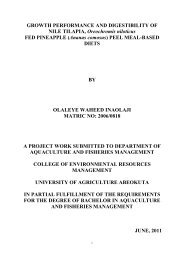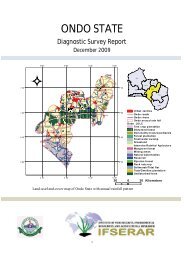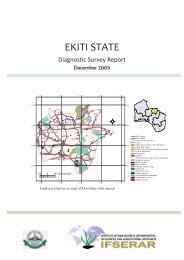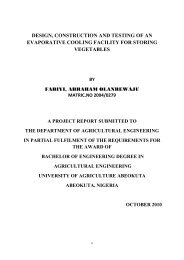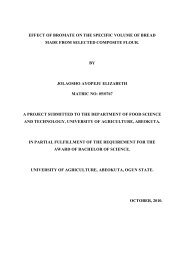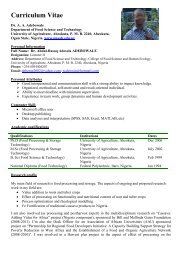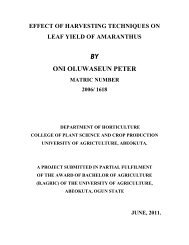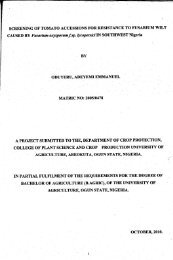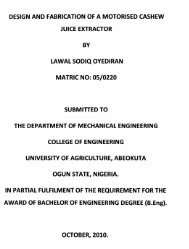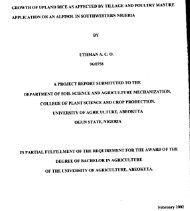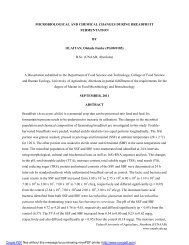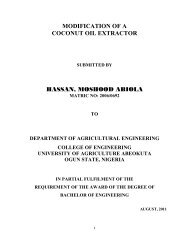Evaluation of Soil fertility Management Practices by Rice Farmers i
Evaluation of Soil fertility Management Practices by Rice Farmers i
Evaluation of Soil fertility Management Practices by Rice Farmers i
Create successful ePaper yourself
Turn your PDF publications into a flip-book with our unique Google optimized e-Paper software.
American-Eurasian Journal <strong>of</strong> Agronomy 2 (2): 45-49, 2009<br />
ISSN 1995-896X<br />
© IDOSI Publications, 2009<br />
<strong>Evaluation</strong> <strong>of</strong> Traditional <strong>Soil</strong> Fertility <strong>Management</strong> <strong>Practices</strong> for<br />
<strong>Rice</strong> Cultivation in Southwestern Nigeria<br />
1 2 3 4 5<br />
O.O. Adesanwo, M.T. Adetunji, J.K. Adesanwo, O.A. Osiname, S.Diatta and D.O. Torimiro<br />
1<br />
Department <strong>of</strong> <strong>Soil</strong> Science, Obafemi awolowo University, Ile-Ife, Nigeria.<br />
2<br />
Department <strong>of</strong> <strong>Soil</strong> Science and Land <strong>Management</strong>,<br />
Federal University <strong>of</strong> Agriculture, Abeokuta Ogun State, Nigeria<br />
3<br />
Chemistry Department, Obafemi Awolowo University, Ile -Ife, Nigeria<br />
4<br />
African <strong>Rice</strong> Center (WARDA) IITA, Ibadan, Nigeria,<br />
5<br />
Department <strong>of</strong> Agricultural Extension and Rural Development,<br />
Obafemi Awolowo University, Ile-Ife<br />
Abstract: <strong>Management</strong> <strong>of</strong> soil <strong>fertility</strong> is one <strong>of</strong> the major factors limiting sustainable production <strong>of</strong> rice in<br />
Nigeria. A survey was carried out to identify farmers’ soil <strong>fertility</strong> management methods and its impact on soil<br />
properties, to introduce them to soil testing programme and a low cost soil <strong>fertility</strong> management method.<br />
Structured questionnaire was distributed to 55 rice famers in southwestern Nigeria. <strong>Soil</strong> samples were also taken<br />
from selected farmers’ field to determine the effect <strong>of</strong> their <strong>fertility</strong> management methods on soil properties. The<br />
effectiveness <strong>of</strong> a low cost method was tested on two farmers’ field using a local variety (Ofada) common with<br />
rice farmers and improved variety ITA 150. Legume treatment consisted <strong>of</strong> cowpea and mucuna planted as<br />
pre-rice crop. Four rates <strong>of</strong> Ogun phosphate rock was uniformly spread on the plots with and without legume<br />
1<br />
biomass arranged in split plot design. NPK at 60kg haG was applied as control. Result <strong>of</strong> the survey showed<br />
that soil <strong>fertility</strong> methods practiced <strong>by</strong> rice farmers interviewed can neither sustain nor improve soil <strong>fertility</strong>.<br />
1<br />
There was no significant difference in rice yield between plots treated with NPK (2.96 tons haG ) and<br />
1 1<br />
combination <strong>of</strong> legume and rock phosphate at 60 kg P haG (2.94 tons haG ) at Ayiwere similar result was<br />
1<br />
obtained with plots treated with cowpea and phosphate rock at 60 kg haG at Ikenne. Hence the use Ogun<br />
phosphate rock as low cost P fertilizer for optimal and sustainable crop production when combined with legume<br />
biomass on slightly acidic to lightly alkaline soils is feasible.<br />
Key words: Participatory Approach, Phosphate rock, <strong>Soil</strong> <strong>fertility</strong>, <strong>Soil</strong> testing programme<br />
INTRODUCTION<br />
local production [3] which could still not go round<br />
many <strong>of</strong> the farmers. However, limited financial<br />
The management <strong>of</strong> soil <strong>fertility</strong> is the first condition resources in the country cannot sustain importation or<br />
for sustainable crop production and poses a great establishment <strong>of</strong> more fertilizer plant, More so recent<br />
challenge to farmers in Nigeria, most especially rice findings have shown that the excessive use <strong>of</strong> these<br />
farmers. Local rice production was very poor due to rapid mineral fertilizers, due to lack <strong>of</strong> technical know-how on<br />
decline in soil <strong>fertility</strong>. Huge quantity and value on an the part <strong>of</strong> farmers, could be detrimental to the resource<br />
annual basis stands over 1,000,000 metric tones and $300 base [4]. Hence, the use <strong>of</strong> mineral fertilizer as a means <strong>of</strong><br />
million respectively <strong>by</strong> the Nigeria government on maintaining soil <strong>fertility</strong> is gradually fading away. Against<br />
importation <strong>of</strong> rice in order to meet the demand <strong>of</strong> the this background, it then becomes necessary to evaluate<br />
growing populace [1]. Phosphorus deficiency has been soil <strong>fertility</strong> management practice <strong>of</strong> rice farmers with the<br />
found to be one <strong>of</strong> the major constraints to crop aim <strong>of</strong> improving <strong>fertility</strong> status <strong>of</strong> the soil on a<br />
production in West Africa [2]. Nigeria imports about sustainable basis in order to boost the production <strong>of</strong> rice<br />
200,000 tonnes <strong>of</strong> P fertilizer annually to augment the in the country.<br />
Corresponding Author: O.O. Adesanwo, Department <strong>of</strong> <strong>Soil</strong> Science,<br />
Obafemi awolowo University, Ile-Ife, Nigeria.<br />
45
Am-Euras. J. Agron., 2 (2): 45-49, 2009<br />
METHODOLOGY<br />
A participatory approach was used, which involves<br />
farmers’ involvement right from the early stage <strong>of</strong><br />
problem identification, to the final stage <strong>of</strong> developing<br />
viable solution. Specifically, the effectiveness <strong>of</strong> farmers’<br />
management practices on soil properties was evaluated;<br />
and they were introduced to soil testing programme<br />
and a low cost soil <strong>fertility</strong> management technology<br />
Diagnostic phase involved three parts namely: on farm<br />
assessment; assessment <strong>of</strong> farmers’ <strong>fertility</strong> management<br />
method; and introduction to soil testing programme and<br />
a low cost soil <strong>fertility</strong> management practice which<br />
combines local knowledge with research based insights.<br />
On Farm Assessment: A survey was carried out in<br />
seventeen rice growing communities viz: Obada-oko, Lala,<br />
Awado, Alapako, Ibogun ola oparun, Akodu, Akiniyi,<br />
Ibooro, Ayiwere, Lufoko, Oluwo-oke, Moloko-Asipa,<br />
Ogba-it, Wemode village, Onigbagbo, Ake and Ilogunorile<br />
in Ewekoro, Ifo, Obafemi /Owode, Abeokuta north<br />
and Yewa south local government areas across Egba<br />
division <strong>of</strong> Ogun State. Fifty-five (55) rice farmers under<br />
the Ogun State Agricultural Development Project<br />
(OGADEP) were randomly selected for the study. A<br />
structured interview schedule was administered among<br />
the rice farmers to know the depth <strong>of</strong> their knowledge<br />
about soil and its management. Questions based on<br />
different types <strong>of</strong> soil, ways <strong>of</strong> identifying decline in soil<br />
<strong>fertility</strong>, factors affecting selection <strong>of</strong> farmland and their<br />
management practices were asked. OGADEP extension<br />
workers in Participatory Technology Development<br />
Progamme (PTDP) under African <strong>Rice</strong> Center, IITA,<br />
Ibadan, Nigeria were used as enumerators in administering<br />
the research instrument.<br />
Assessment <strong>of</strong> <strong>Farmers</strong>’ <strong>Soil</strong> Fertility <strong>Management</strong><br />
Practice: Effectiveness <strong>of</strong> their soil <strong>fertility</strong> management<br />
practices was monitored <strong>by</strong> a more formal quantitative<br />
assessment such as soil sampling (0-20cm) from five<br />
farmers’ fields (one in each <strong>of</strong> the local government areas).<br />
The samples collected were subjected to both physical<br />
and chemical analyses. The results <strong>of</strong> the analyses were<br />
presented to farmers in form <strong>of</strong> bar diagrams.<br />
<strong>Soil</strong> Testing Programme (STP): The importance <strong>of</strong> soil<br />
testing programme as a key determining factor in<br />
assessing good management practice was introduced to<br />
farmers <strong>by</strong> likening management <strong>of</strong> soil <strong>fertility</strong> with a<br />
medical examination [5] using the underlisted questions as<br />
a model:<br />
C What happens if you work without taking good and<br />
balanced food?<br />
C What steps does a doctor take when a patient is sick<br />
C What would happen if the doctor prescribed medicine<br />
for you without examining you?<br />
C What would happen if a doctor gives a wrong<br />
medicine?<br />
C Do patients have to pay for examination?<br />
A low cost <strong>fertility</strong> management practice which<br />
involves the use <strong>of</strong> legume and indigenous phosphate<br />
rock found in southwestern Nigeria was introduced to<br />
farmers. The experiment was tested on two farmers field.<br />
Field Experiment: The field trials was established on two<br />
farmers’ sites in southwestern Nigeria (Ikenne and<br />
Ayiwere) Land clearing method used <strong>by</strong> farmers<br />
concerned was adopted. Composite samples were taken<br />
before cropping and subjected to both physical and<br />
chemical analysis. Legume treatment consisted <strong>of</strong> cowpea<br />
(IT98K-356-1) and mucuna as agreed <strong>by</strong> rice farmers in<br />
Ogun state and were planted as pre-rice crop in a spacing<br />
<strong>of</strong> 25cm <strong>by</strong> 50 cm. Four rates <strong>of</strong> P (0, 30, 60 90 Kg P haG 1 )<br />
as Ogun phosphate rock was applied in triplicates before<br />
planting legume. Cowpea seeds were harvested three<br />
months after planting while its biomass and mucuna plant<br />
remain on the field and later incorporated into the soil plot<br />
<strong>by</strong> plot a month before planting rice. <strong>Farmers</strong> favorite rice<br />
variety (Ofada: four month duration crop) was used along<br />
side with an improved rice variety (ITA150: three month<br />
duration crop). The rice seeds was planted in a spacing <strong>of</strong><br />
1<br />
20 cm <strong>by</strong> 20 cm. NPK at 60 kg P haG was used as control.<br />
Grain yield per plot at 14% moisture content was recorded.<br />
Two border rows was removed from each side <strong>of</strong> plot for<br />
yield recording.<br />
RESULTS<br />
Diagnostic Survey<br />
<strong>Farmers</strong> Perspective <strong>of</strong> <strong>Soil</strong>: About 87% <strong>of</strong> 55 rice<br />
farmers interviewed were male, the rest female. The result<br />
showed that 91% <strong>of</strong> the farmers used the <strong>fertility</strong> status <strong>of</strong><br />
the soil as a major criterion for selecting farm land, while<br />
others used length <strong>of</strong> fallowing and type <strong>of</strong> crop to be<br />
planted. They all depended on physical features like<br />
presence <strong>of</strong> earthworm cast, plant indicator as shown in<br />
Figure 1 to assess <strong>fertility</strong> status <strong>of</strong> a soil. All the farmers<br />
interviewed agreed to the importance <strong>of</strong> maintaining soil<br />
<strong>fertility</strong> for crop production. Analysis <strong>of</strong> various methods<br />
46
No. <strong>of</strong> farmers (%)<br />
45<br />
40<br />
35<br />
30<br />
25<br />
20<br />
15<br />
10<br />
5<br />
0<br />
Earthworm<br />
cast<br />
Fig. 1: Methods <strong>Farmers</strong> used to identify fertile soils<br />
Am-Euras. J. Agron., 2 (2): 45-49, 2009<br />
Plant Digging Plant growth Color <strong>of</strong> soil Crop yield<br />
indicator deep<br />
Physical features used <strong>by</strong> farmers<br />
Table 1: Cropping system practiced <strong>by</strong> five selected farmers after five year<br />
fallow period<br />
showed that greater number <strong>of</strong> them believed that<br />
fallowing is the best method to maintain soil <strong>fertility</strong>, some<br />
Location Local Govt. Area Cropping practice Cropping period farmers adopted the use <strong>of</strong> cover crop, mulching (Table 2).<br />
Moloko Asipa Abeokuta North Sole cropping 2years Survey also revealed that farmers’ record keeping was<br />
Ilaho Ifo Maize/cassava/rice 3years poor, cropping practices differ from one local government<br />
Iperu Yewa South Sole cropping 2 years<br />
area to another (Table 1). Seminar delivered on the<br />
importance <strong>of</strong> soil testing programme was revealing, about<br />
Wasimi Ewekoro Cassava / rice 3 years<br />
90% <strong>of</strong> the farmers present signified willingness to have<br />
Ayiwere Obafemi / Owode Sole cropping 2 years<br />
soil testing carried out on their farm land before planting.<br />
Results <strong>of</strong> the chemical analysis carried out on soil<br />
Table 2: Various methods used <strong>by</strong> <strong>Rice</strong> farmers to maintain soil <strong>fertility</strong><br />
samples taken from the five farmers’ field before planting<br />
Method<br />
Percentage<br />
after five year fallow (Table 3) showed slightly acidic to<br />
Fallowing 42.9 slightly alkaline soils (soil pH range from 5.5 to 7.3). <strong>Soil</strong><br />
Planting <strong>of</strong> cover crop 19.0 organic mater content ranged between 2.40 and 4.06 g<br />
Decay <strong>of</strong> leaves on the farm (Mulching) 9.5<br />
1<br />
kgG . The nitrogen content ranges from 0.094 to 0.14 g<br />
Fertiliser application 9.5<br />
1<br />
kgG , available P value varied widely from 5.8 to 21.2 mg<br />
Planting <strong>of</strong> Potato 4.8<br />
1<br />
kgG . Exchangeable cations varied slightly across the five<br />
1<br />
Shifting cultivation 4.8 locations, ranging from: Ca (2.9-8.0 cmol kgG ), K (0.1 to<br />
1 1<br />
Hoeing (Minimum Tillage) 4.8 0.4 cmol kgG ) and Mg (1.1 to 1.8 cmol kgG ). Fe content<br />
Melon leaves 4.3<br />
1<br />
was highest in Ilaho (31 kg haG ) and lowest in Wasimi<br />
1<br />
(19.2 kg haG ).<br />
Table 3: Chemical properties <strong>of</strong> the soil samples from five farmers field taken before planting<br />
Parameters Moloko Asipa Ilaho Iperu Wasimi Ayiwere<br />
pH (H O) 5.4 6.0 6.5 7.3 5.6<br />
2<br />
1<br />
Org.C (g kgG ) 3.26 4.06 2.44 3.07 2.58<br />
1<br />
Total N (g kgG ) 0.10 0.13 0.14 0.10 0.11<br />
1<br />
Avail. P (mg kgG ) 5.8 20.2 12.8 21.2 7.5<br />
Exchangeable cations (cmol kgG 1 )<br />
Ca 3.5 6.2 5.4 8.0 2.9<br />
K 0.2 0.4 0.1 0.3 0.2<br />
Mg 1.1 1.1 1.3 1.8 1.2<br />
Al 0.0 0.3 0 0 0<br />
Micronutrient<br />
1<br />
Fe (kg haG ) 30 31 27 19.2 23.4<br />
47
Am-Euras. J. Agron., 2 (2): 45-49, 2009<br />
Table 4:<br />
Comparative evaluation <strong>of</strong> the effect <strong>of</strong> combination <strong>of</strong> legume and<br />
Ogun phosphate rock on rice yield across the two sites with the<br />
two rice varieties<br />
Site/variety <strong>Rice</strong> yield (tons haG 1 )<br />
Ikenne 2.68a<br />
Ayiwere 2.08b<br />
ITA150 2.54a<br />
Ofada 2.22a<br />
†Within a column means followed <strong>by</strong> the same letter are not significantly<br />
different according to Fisher’s LSD at 0.05 probability level.<br />
Table 5: Effect <strong>of</strong> the treatments on <strong>Rice</strong> yield<br />
<strong>Rice</strong> yield (tons haG 1 )<br />
Treatments -------------------------------------------<br />
1<br />
Legume P rates (kg haG ) Ayiwere Ikenne<br />
Mucuna O 1.38cde 2.98ab<br />
30 2.33abc 2.6abc<br />
60 2.94a 2.96ab<br />
90 2.63ab 2.80abc<br />
Cowpea O 2.31abc 2.64abc<br />
30 2.23abc 2.44abc<br />
60 2.18abc 3.48a<br />
90 1.85bcde 3.11ab<br />
No legume 0 0.93e 1.96bc<br />
30 1.06de 1.66c<br />
60 2.02abcd 2.04bc<br />
1<br />
TSP (40 kg haG ) 90 2.96a 3.49a<br />
†Within a column means followed <strong>by</strong> the same letter are not significantly<br />
different according to Fisher’s LSD at 0.05 probability level<br />
Plots treated with NPK produced the highest rice<br />
1<br />
yield (3.94 and 2.96 tons haG at Ikenne and Ayiwere<br />
respectively)though not significantly different from plots<br />
treated with combination <strong>of</strong> legume biomass and Ogun<br />
phosphate rock but a significant increase was observed<br />
over plots treated with phosphate rock alone (Table 5).<br />
There was no significant difference in grain yield with<br />
the two rice varieties (Table 4). Among legume<br />
treatments, plots treated with mucuna performed better<br />
in Ayiwere while cowpea treatment performed better at<br />
Ikenne (Table 5).<br />
DISCUSSION<br />
This research used the Participatory Technology<br />
Development approach to introduce farmers to a low input<br />
soil <strong>fertility</strong> management practice that will combine local<br />
knowledge with research based insights to make the most<br />
effective use <strong>of</strong> locally available resources with little or no<br />
detrimental effect on the resource base. The fact that<br />
majority <strong>of</strong> rice farmers interviewed (91%) used <strong>fertility</strong><br />
status <strong>of</strong> a soil as a major criterion for selecting farmland<br />
is a clear indication <strong>of</strong> how highly they value soil <strong>fertility</strong>.<br />
The outcome <strong>of</strong> the meeting held with rice farmers in<br />
Abeokuta when soil testing programme (STP) was<br />
introduced was revealing where 90% the farmers present<br />
agreed to the importance <strong>of</strong> STP as a tool for good soil<br />
<strong>fertility</strong> management practice. This confirms the fact that<br />
participatory approach <strong>of</strong> disseminating new technology<br />
to farmers is viable as observed <strong>by</strong> Ramaru et al. [5].The<br />
participatory technology approach brings scientists and<br />
farmers to share ideas and plan together unlike former<br />
approaches <strong>of</strong> passing down information to farmers where<br />
farmers participation in research was very poor. The soil<br />
test results from the analysis <strong>of</strong> soil samples taken<br />
randomly from the farmers’ field showed that their<br />
management method can neither improve soil <strong>fertility</strong> nor<br />
sustain crop production. Fallow periods <strong>of</strong> five years<br />
maintained <strong>by</strong> most <strong>of</strong> them is too short to ensure<br />
adequate replenishment unless external input is<br />
introduced and very few farmers had access to mineral<br />
fertilizer. The result <strong>of</strong> this survey clearly revealed the<br />
urgent need for a low cost and sustainable soil <strong>fertility</strong><br />
management method. Plots treated with mucuna and<br />
1<br />
phosphate rock at 60 kg haG performed comparably well<br />
with NPK treatments at Ayiwere while plots treated with<br />
1<br />
cowpea and phosphate rock at 60 kg haG at Ikenne. The<br />
highest value recorded with plots treated with NPK could<br />
be as a result <strong>of</strong> its high solubility and fast rate <strong>of</strong> P<br />
release to crop compared with phosphate rock. A<br />
significant difference observed with the two legume crops<br />
could be attributed to differences in their chemical<br />
properties as confirmed <strong>by</strong> Tian et al. [6]. Significant<br />
differences in rice yield from these sites could partly<br />
be attributed to inherent physical and chemical<br />
properties <strong>of</strong> the soils coupled with the fact that<br />
Ikenne was formed on a sedimentary rock while<br />
Ayiwere soils was formed on basement complex as<br />
reported <strong>by</strong> Moormann, [7]. Positive results obtained from<br />
OPR treatment when combined with legume on soils that<br />
are not acidic could have been as a result <strong>of</strong> modification<br />
<strong>of</strong> soil conditions through the decomposition <strong>of</strong> legume<br />
which releases organic acids and nutrients. Evidences<br />
confirmed so far suggest that these acids can enhance the<br />
dissolution <strong>of</strong> elements from minerals due to their acidity<br />
and to a greater extent <strong>by</strong> a complex formation.<br />
Consequently, the increased solubility <strong>of</strong> less reactive<br />
48
Am-Euras. J. Agron., 2 (2): 45-49, 2009<br />
OPR could be attributed to the action <strong>of</strong> the products<br />
REFERENCE<br />
<strong>of</strong> decomposition <strong>of</strong> legume biomass. Chelation <strong>of</strong><br />
Ca from OPR resulting in increase P release [8] which 1. Nkang, N.M., S.O. Abang, O.E. Akpan and E.O. Edet,<br />
will contribute to grain yield could be another probable 2006. <strong>Rice</strong> Production, imports and Food Security in<br />
reason for the significant positive effect observed Nigeria: an Application <strong>of</strong> Cointegration and error<br />
on rice grain. There was no significant difference in correction model. Journal <strong>of</strong> Food, Agriculture and<br />
rice yield with Ofada, a four months duration crop and Environment 4(10): 86 -90.<br />
ITA 150, a three month duration crop. it is therefore 2. Sahrawat, K.L., M.P. Jones and S. Diatta, 1995.<br />
envisaged that planting ITA 150 would give a better Communication in <strong>Soil</strong> Sciences and Plant Analysis,<br />
economic return to farmers however there is need for 28: 1532-2416.<br />
further confirmation. 3. Fertilizer Procurement and Distribution Division<br />
CONCLUSION<br />
(FPDD), 1990, I.A Review <strong>of</strong> <strong>Soil</strong> and Fertilizer Use<br />
Research in Nigeri. In: Literature Review on soil<br />
Participatory technology approach in disseminating<br />
Fertility Investigation in Nigeria (Eds enwezor et al.),<br />
produced in Five Volumes <strong>by</strong> the Fertilizer<br />
research results to farmers proves a viable tool for Procurement and Distribution (FPDD), Federal<br />
passing down new research findings to farmers. Result <strong>of</strong> Ministry <strong>of</strong> Agriculture and Natural Resources,<br />
the diagnostic survey showed that soil <strong>fertility</strong> methods Lagos, Nigeria, 281 pp.<br />
practiced <strong>by</strong> rice farmers interviewed can neither sustain 4. Capenter, S., N. Canaco, D. Correl, R. Howaath, A.<br />
nor improve soil <strong>fertility</strong>. The present study indicated that Sharpley and V. Smith, 1998. Nonpoint pollution <strong>of</strong><br />
the Ogun phosphorite in combination with legume has surface waters with phosphorus and nitrogen. Ecol.<br />
dual purpose to give adequate amount <strong>of</strong> nitrogen to the Application, 8; 559-568<br />
growing crop and as a potential source <strong>of</strong> natural P 5. Ramaru, J., Z. Mamabolo and J. Lekgoro, 2000.<br />
fertilizer.<br />
Improving soil <strong>fertility</strong> management in South Africa:<br />
learning through participatory extension approaches.<br />
ACKNOWLEDGEMENT Managing Africa's <strong>Soil</strong>s No. 19<br />
6. Tian, G., B.T. Kang and L. Brussard, 1992.<br />
African rice Center IITA, Ibadan in Effect <strong>of</strong> chemical composition on N, Ca and<br />
collaboration with University <strong>of</strong> Hohenheim, Germany Mg release during incubation <strong>of</strong> leaves from<br />
for fellowship to carry out doctoral research from selected agr<strong>of</strong>orestry and fallow plants.<br />
Participatory Technology Development Project (PTDP) Biogeochem., 16: 103-119.<br />
Funds. 7. Moorman, F.R., R. Lal and A.S.R. Juo, 1985. The <strong>Soil</strong>s<br />
<strong>of</strong> IITA, IITA Technical Bulletin No. 3 48pp<br />
8. Chien, S.H., 1992. Reactions <strong>of</strong> phosphate rocks with<br />
acid soils <strong>of</strong> the humid tropics. In A.T. Bachik and A.<br />
Bidin, eds. Proceedings <strong>of</strong> a workshop on phosphate<br />
sources for acid soils in the humid tropics <strong>of</strong> Asia,<br />
pp. 18-29. Kuala Lumpur, Malaysian Society <strong>of</strong> <strong>Soil</strong><br />
Science.<br />
49



